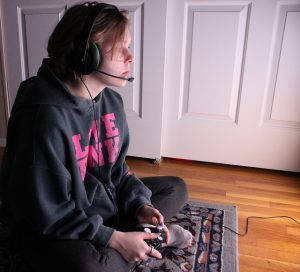Porn Hub is the 10th most visited website in the world, and #3 in bandwidth use, behind Google and Netflix. It’s had an explosion in traffic since Covid 19 put us all under lockdown with too much time in front of our screens. Teens are watching too, but YOU (the parent) have no idea how much: “Research demonstrates that parents are, for the most part, unaware of their children’s porn usage, with half of parents unaware their teens had seen pornography and teens having seen up to 10 times more pornography than their parents believe. Parents especially underestimated their teen’s exposure to extreme content, such as violent porn, which is just as easy to access as traditional pornography content” (quote from this article). For some time, a woman named Laila Mickelwait has tried to get the world to pay attention to the dangerous and illegal activity on the site, including starting an online petition to shut it down that now has over 2 million signatures. Finally, the New York Times was spurred to investigate, and found that the worst imaginable kinds of exploitation were to be found on Pornhub. This led to Canadian company, MindGeek, the owner of the site, taking down 13 million videos, leaving 3 million. In addition, Visa, Mastercard and Discover Card will no longer process payments for purchases  on the site. A lawsuit by 40 victims was filed in December, and now a Canadian government Ethics Committee is (this week) hearing testimony from victims, including a girl who was as a 7th grader persuaded by a boy she had a crush on to send a naked picture, which ended up on Pornhub. Her saga has been covered by Dr. Oz, in a must-watch video (must-watch WITH your teen, that is, to warn them about the consequences of sexting). Her story shows how a single moment of weakness can lead to years of emotional torture and public exploitation through sites like Pornhub that allow posting of content without consent, and are infested with illegal pictures and videos such as those showing the actual rape and assault of both adults and children.
on the site. A lawsuit by 40 victims was filed in December, and now a Canadian government Ethics Committee is (this week) hearing testimony from victims, including a girl who was as a 7th grader persuaded by a boy she had a crush on to send a naked picture, which ended up on Pornhub. Her saga has been covered by Dr. Oz, in a must-watch video (must-watch WITH your teen, that is, to warn them about the consequences of sexting). Her story shows how a single moment of weakness can lead to years of emotional torture and public exploitation through sites like Pornhub that allow posting of content without consent, and are infested with illegal pictures and videos such as those showing the actual rape and assault of both adults and children.
Teens Sex Trafficked at an Early Age
Almost a decade ago, I attended a seminar on human trafficking, and was astounded to find out that it happens here…in America…to vulnerable teens. It could happen to your neighbor’s child, or your child’s schoolmate or friend. The Daily Herald, in an article about a newly opened home for those rescued from sex trafficking, said: “The average age of entry into the life of trafficking is 12-14 years of age, and recruitment of these young girls and boys often happens through social media and online grooming tactics.”
Geoff Rogers, co-founder of the United States Institute Against Human Trafficking (USIAHT) said in an interview that the U.S. is the biggest consumer of sex in the world, and that “We’re also driving the demand with our own people, with our own kids.” Rogers noted that “there are tremendous numbers of kids, a multitude of kids that are being sold as sex slaves today in America…50 percent to 60 percent of them coming out of the foster care industry.” The State Department in 2017 reported that children who are at special risk include those in foster care, homeless youth, undocumented immigrant children and those with substance abuse problems. This article includes real stories of trafficked youth (it’s from a faith-based site, but is still informative for all audiences). The article talks about how we can be alert to situations that might be going on in front of our eyes, and also includes information on a film on human trafficking that will be in limited release in theaters January 23.
being sold as sex slaves today in America…50 percent to 60 percent of them coming out of the foster care industry.” The State Department in 2017 reported that children who are at special risk include those in foster care, homeless youth, undocumented immigrant children and those with substance abuse problems. This article includes real stories of trafficked youth (it’s from a faith-based site, but is still informative for all audiences). The article talks about how we can be alert to situations that might be going on in front of our eyes, and also includes information on a film on human trafficking that will be in limited release in theaters January 23.
Parents Concerned About TikTok and Other Top Apps
Just when we think we’ve learned the latest teen trends, our kids and their peers reinvent themselves yet again online. If you don’t know what a VSCO girl is (but you’ve been asked to buy a $40 Hydro Flask® for your teen), you’re hopelessly behind, for instance. I happen to have a teen in my home that educates me about the latest teen trends, but it’s never enough to keep up. So I’ve connected HERE to a site that has short descriptions of popular apps, including which apps are appropriate and safe, which you should be concerned about, and which the site warns against.
The app overtaking others in popularity right now is Tic Tok (formerly musical.ly). Tic Tok is mostly used by teens to post short-form videos of themselves lip synching, singing, dancing, and doing comedy. Concerns have to do with privacy, inappropriate content, and potential predator contact. Kidsnclicks shows with screen shots how to set your child’s Tik Tok to “private” which is probably the most important thing you can do to protect them on the app. Now, our government is even looking into national security issues with Tik Tok (it is Chinese-owned). As always, we suggest you educate yourself, and be aware as a parent.
synching, singing, dancing, and doing comedy. Concerns have to do with privacy, inappropriate content, and potential predator contact. Kidsnclicks shows with screen shots how to set your child’s Tik Tok to “private” which is probably the most important thing you can do to protect them on the app. Now, our government is even looking into national security issues with Tik Tok (it is Chinese-owned). As always, we suggest you educate yourself, and be aware as a parent.
Teens’ YouTube Screen Time is Through the Roof
“Kids spend more time with media and technology than they do with their parents, time in school, or any other thing. They are literally living in a 24/7 media and technology world,” says James Steyer, founder and CEO of Commonsense Media about a 2019 survey of (non-homework) teen screen use. The number 1 activity is watching videos, with YouTube being their first choice, and actual TV watching dropping dramatically in even just the last 4 years. This means that families are not watching together, you can’t walk into the room and see what TV show your kids are watching, and therefore you probably have no clue WHAT they’re watching.
 Wouldn’t you LIKE to know what your child is filling their eyes and mind with all those hours every day? Commonsense Media has a great place to start getting educated with their Parents’ Ultimate Guide to YouTube .
Wouldn’t you LIKE to know what your child is filling their eyes and mind with all those hours every day? Commonsense Media has a great place to start getting educated with their Parents’ Ultimate Guide to YouTube .
If you discover that some things they’re accessing (or that they could access) are troublesome, you may want to check out this parental control guide to setting restrictions using YouTube settings.
Sleep: The Best Medicine

Some school districts, according to one article on teens and the neuroscience of risky behavior, have taken to heart studies that connect sleep deprivation to teen risk-taking–such as drug and alcohol use, and risky sexual behaviors: “Dozens of studies on the effects of increasing sleep by delaying school start times—a move endorsed by bodies such as the US Centers for Disease Control and Prevention and the American Academy of Pediatrics—suggest that many of these problems, including risky behaviors, improve when schools start later.” But even if you’re lucky enough to live in such a district, that that still doesn’t mean your child is getting enough sleep…they may just be staying up later. Many of us are worried about the late night Netflix binging, the social media surfing, and the general tendency of teens to stay up too late. And there’s reason to worry! This article on sleep-deprived teens (those who don’t get the recommended 8-10 hours), states that “researchers found that adolescents who were short weekday and short weekend sleepers (i.e., those who consistently did not get enough sleep) were nearly two times more likely to engage in unsafe sex than those who slept in, on average, an extra 3.5 hours on weekends.” Said the researchers: “Our recommendation is for parents and teens to find a middle ground, which allows for some weekend catch-up sleep, while maintaining some level of consistency in sleep-wake patterns.”
Besides letting them catch up on the weekends, wouldn’t it be better to send your child to school well-rested every day? Why not have some parental backbone, set some bedtime rules, and stick to them. In my home, I’ve for 6 years filled my empty nest with foreign students going to high school in America. This year I have four of them! The international program at the school has rules that I’m expected to enforce as a host parent. One of them is that studying happens in a study area downstairs, and bedrooms are device free. If that seems impossible to imagine implementing without all-out mutity, what about “Devices on the hall table by 10:30.” If you’re tech savvy you can do what my husband did…turn off the wifi at a certain hour at night, and don’t get an unlimited data plan for the cell phone.
If you need fortification to be tough…remember, it’s for their own good!
Videos by teens, for teens
I recently came across the OK, Inc. YouTube channel, with dozens of videos on topics teens say they want addressed…things such as date rape, bullying, sexting, abusive relationships, substance abuse, etc. These videos use high school students as actors and portray realistic scenarios. I watched several that have been viewed by millions, and can recommend them as excellent tools for parents and teachers.
These short story videos help teens recognize risky situations, make good choices, deal with consequences, and see a way forward even after making a poor choice. Every video has an example of friends who help their friends along the way. Parents, don’t we want to see our child learn now how to have good relationships, choose well when faced with negative pressures, and to BE a good, supportive friend to others who are caught in bad decisions, or bad relationships? Sometimes, all the good advice we know we could give is better received coming from peers. These videos provide a creative way to open conversations with our children about the pressures and problems they face in everyday life, without coming across as too “preachy.” I urge you to watch and discuss as many of these videos with your teens as possible.
after making a poor choice. Every video has an example of friends who help their friends along the way. Parents, don’t we want to see our child learn now how to have good relationships, choose well when faced with negative pressures, and to BE a good, supportive friend to others who are caught in bad decisions, or bad relationships? Sometimes, all the good advice we know we could give is better received coming from peers. These videos provide a creative way to open conversations with our children about the pressures and problems they face in everyday life, without coming across as too “preachy.” I urge you to watch and discuss as many of these videos with your teens as possible.
Sextortion a Threat to More Teens
A single poor choice…often motivated by a desire to keep or gain a relationship, can lead to the dark, ugly world of “sextortion.” An article on the site HealthDay, recounts the tragic case of a 12-year-old girl who’d lifted her shirt online at the request of someone she’d never met in person (and who turned out to be an adult man). She did not give in to the threat of the exposure of that picture, and the extortionist followed through, with the sexual picture spreading around her school. She was then hounded by that man and others for years, finally committing suicide at 16. The difference between that high-profile story and the reality for most, is that perpetrators usually know the victims.
The health site “HealthDay” defines sextortion as “threatening to share sexually explicit photos without consent if a person doesn’t agree to certain demands, such as sexual favors or money,” and reports that 5 percent of teens have been victims, and another 3 percent have been perpetrators. That may seem like a small number, but that means that in every classroom of teens, across America, 2-3 people have been involved in sextortion.  Certain groups are more at risk, according to the article: “Teens who identified as non-heterosexual were more than twice as likely to be the victim of sextortion…. Fifteen appears to be the most common age to be involved in sextortion, the new study found. One finding parents may find particularly alarming is that teens being victimized by sextortion attempts usually know the person trying to take advantage of them. They may have been a romantic partner or a friend. It’s unusual for someone to be targeted by a stranger, the researchers said.”
Certain groups are more at risk, according to the article: “Teens who identified as non-heterosexual were more than twice as likely to be the victim of sextortion…. Fifteen appears to be the most common age to be involved in sextortion, the new study found. One finding parents may find particularly alarming is that teens being victimized by sextortion attempts usually know the person trying to take advantage of them. They may have been a romantic partner or a friend. It’s unusual for someone to be targeted by a stranger, the researchers said.”
Talking to our teens about setting boundaries in relationships and in online interactions is critical to their safety, and specifically addressing sextortion might help our children stay safe when, in a single moment, they might be lured into a lapse of judgment that has years-long consequences. Even if it doesn’t happen to your teen, equipping teens to be wise and watchful can help them know how to help their friends stay safe as well.
Apple’s Controls Help You Limit Teen’s Phone Use
I don’t have an iPhone, but almost all the teens I know do…as do many parents. Did you know Apple has made it possible for you to do all sorts of things to limit your teen’s use of their phone? And with the IOS 12 update coming in about 10 days, there are some exciting enhancements and new parental control features. According to Apple, these new features “include Activity Reports, App Limits and new Do Not Disturb and Notifications controls designed t o help customers reduce interruptions and manage screen time for themselves and their families.” Here are a couple of articles that can guide you, including one where an adult reviewer borrowed a teen to try it out on…with success: Teen learns limits and Features overview
o help customers reduce interruptions and manage screen time for themselves and their families.” Here are a couple of articles that can guide you, including one where an adult reviewer borrowed a teen to try it out on…with success: Teen learns limits and Features overview
So what can do though your own iPhone (or directly on theirs) to help your teen get some of his/her life back that has been sucked into the vortex of social media? Here are some examples:
- Do Not Disturb during Bedtime mode dims the display and hides notifications on the lock screen until prompted in the morning.
- Do Not Disturb during family dinner (that means you too, Mom or Dad)
- Through Screen Time view daily and weekly activity reports to see where all those hours are going, and where limits need to be set.
- Set time limits for apps (Snapchat, Instagram, Fortnite Mobile and YouTube are obvious candidates for this).
I hear it’s easy to set up, so once IOS 12 comes out…go to it! If you have an Android phone, there are parental control apps (cost from $30 up per year) HERE.
Should I be concerned about Fortnite?
 Fortnite is the game every teen is talking about. It’s a multi-player shooter survival game (Mac, PlayStation 4, Windows, Xbox One, IOS app, and soon on Android), with free and paid versions. The obvious violence (it’s about killing with weapons after all) is not graphic–no blood or gore. It is “cartoonish” rather than realistic. No sex, no nudity, although the bodies of the female characters are exaggeratedly curvy. One article explains why it’s so popular with kids: “Well, it’s free, it’s fun and it has a very silly, offbeat sense of humour. While PUGB has a serious, realistic visual style, Fortnite: Battle Royale has very bright, almost cartoon-like graphics as well as loads of ridiculous items and costumes, such as space suits and dinosaur outfits. You can also pull a variety of dance moves during the game, and some of these have taken on a cult appeal in schoolyards around the globe.”
Fortnite is the game every teen is talking about. It’s a multi-player shooter survival game (Mac, PlayStation 4, Windows, Xbox One, IOS app, and soon on Android), with free and paid versions. The obvious violence (it’s about killing with weapons after all) is not graphic–no blood or gore. It is “cartoonish” rather than realistic. No sex, no nudity, although the bodies of the female characters are exaggeratedly curvy. One article explains why it’s so popular with kids: “Well, it’s free, it’s fun and it has a very silly, offbeat sense of humour. While PUGB has a serious, realistic visual style, Fortnite: Battle Royale has very bright, almost cartoon-like graphics as well as loads of ridiculous items and costumes, such as space suits and dinosaur outfits. You can also pull a variety of dance moves during the game, and some of these have taken on a cult appeal in schoolyards around the globe.”
I always urge parents to check out games, videos, etc. on Commonsense Media, and I also found a Good Morning America video discussing the game, its addictive qualities and how to set limits…things most parents are concerned about.
Be THAT parent…
 Controlling and/or monitoring your teen’s internet use is not an intrusion into your child’s privacy.
Controlling and/or monitoring your teen’s internet use is not an intrusion into your child’s privacy.
Wait…yes it is! But it’s NECESSARY. As parents, we’d throw ourselves in front of a speeding car to push our precious child out of the path of harm. In the same way, it’s our job, even duty, to both warn and protect our children from the darker things they can be exposed to on their phones, tablets and laptops. Even if it’s just making sure that gaming doesn’t chew up too much family or homework time, we have an interest in keeping track of what our teens are doing on the internet. There’s no one-size-fits-all software solution. But pcmag.org does have an up-to-date resource page with alternatives for monitoring and/or controlling internet use by your child.
